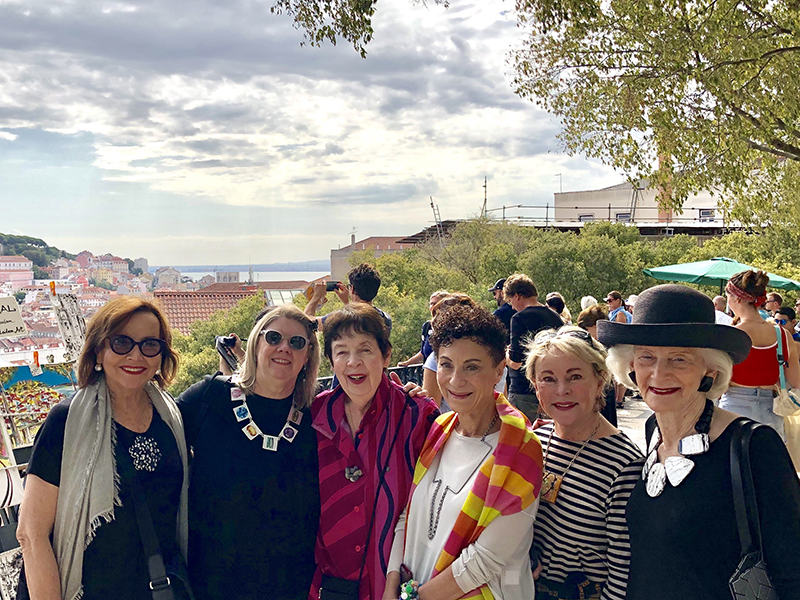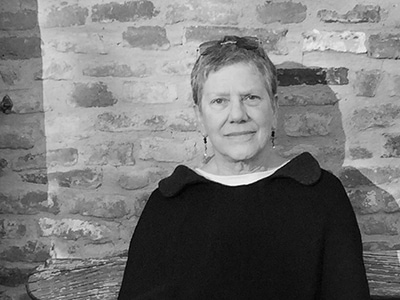
Michele Fox: Tell me about yourself and how/why you joined AJF.
Michele Fox: I grew up in a family where jewelry served the usual roles of demonstrating status and where holidays always brought gifts of classic jewelry. I loved colored stones but admired simple Scandinavian design and dreamed of designing my own. I finally found the time to learn basic techniques and started making jewelry and metal objects about 20 years ago as a hobby, but quickly realized that classic styles and techniques were not what I wanted. It took a friend who was a collector to tell me that what I was probably reaching for was art jewelry. She belonged to AJF and suggested I join, which I did, to be with others with similar interests, to learn more, and to help the field grow.
The trip to Portugal this year is the fourth major AJF trip I’ve made, and on each trip we’ve been welcomed with open hearts by the local jewelers, gallerists, and museum curators. We’ve seen public exhibitions and private pop-ups arranged just for us, been taken on behind-the-scenes looks at exhibits being put together, and museum storage that’s breathtaking in size and content.

Related: Liesbeth den Besten’s First AJF Trip, to NYCJW 2018
Related: AJF’s 2019 Trip to Copenhagen and Oslo
Related: AJF at Schmuck 2017
Ok, now tell me about this trip please.
Michele Fox: The group always has a main hotel, although many attendees stay elsewhere and then congregate in the main hotel in the morning to talk about the day before, or in the evening to talk about what we each thought was most interesting, and often to show new collection pieces from the day before. This year the main hotel was the Ritz Four Seasons in Lisbon, an exceptional hotel in all ways. The trip started with a group welcome dinner at Café Lisboa, one of star chef Jose Avillez’s restaurants, inside the Sao Carlos National Theatre, a beautiful late 18th-century building. We had the restaurant to ourselves, and the local jewelers, gallerists, and curators who had helped organize our different visits in Lisbon were also there to explain what we’d be seeing and doing. As always, the trip would be jam-packed with activities, and stamina would be a necessity!
We started the first full day with a local guide who spoke about Lisbon and Portuguese culture, and then moved on to lunch at Can the Can, a fascinating old fish-canning factory building that has been converted into a café. After lunch we moved to the atelier of Marilia Maria Mira, then on to the Gulbenkian Foundation Museum to see their collection of traditional Portuguese jewelry and a knock-out Lalique jewelry collection so modern it might have been made tomorrow. We celebrated the launch of Cristina Filipe’s new book (the first ever on the history of Portuguese jewelry, and the result of AJF’s Susan Beech Mid-Career Grant), and then had a personally guided tour of her exhibition, where the exhibition design was a beautiful as the jewelry. After that we had a free night for dinner; many of us ended up in the same standout restaurant without knowing in advance we were all going there—perhaps like really does find like?
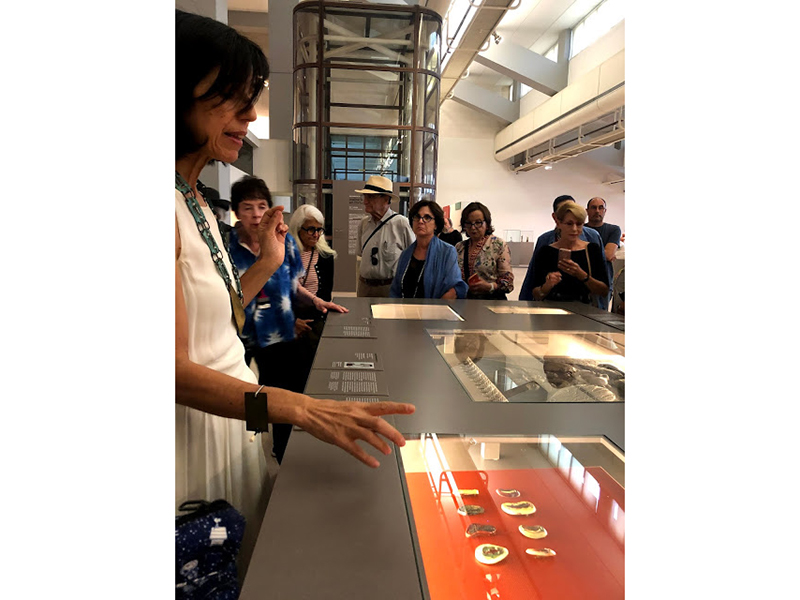
You knew you’d be writing about this trip—what did you do to prepare?
Michele Fox: On a previous trip another group member had jokingly pointed out to me that I always chose the perfect piece of jewelry for myself, and it made me realize that we all curate our appearance—both clothing and jewelry, something which hadn’t really occurred to me … I read a lot about curating and the purpose(s) of jewelry, and then decided I would “prepare” to write by asking everyone why/how they choose to buy the jewelry they do. It surprised me that almost everyone initially said they didn’t really know why they made the choices they did, but they all agreed to think about it and let me ask again during the trip.

That’s an academic approach, rather like an investigative reporter. Didn’t it make you feel like an outsider?
Michele Fox: Yes, in a way, but I also had to interrogate myself as well, which reminded me that I was part of the group.
We met next morning in the Four Seasons lobby, and all admired the new things that some had acquired the day before—a real-time curatorial display. Then we boarded our bus and went to Galeria Reverso, which just celebrated its 20th anniversary, to see a special exhibition of 14 Portuguese jewelers, some well established and others emerging, curated by the gallerist and maker Paula Crespo and a lovely young artist, Carolina Quintela.
Many of us found objects for our collections (I could probably have made a random choice with a blindfold on and been very happy), but each person chose something that everyone agreed was “their style”—so obviously even if we don’t know what our criteria for choosing are, we seem to make recognizable choices. What I like best about the AJF group is that it contains artists/makers, gallerists, curators, and collectors—it gives the group a broad range of points of view and interests. Likewise our local hosts: They’re always an equally diverse group of artists/makers, gallerists, and curators/writers. Most importantly, we get to meet not just the current generation of artists, but their teachers (sometimes going back two or more generations) and students.

Then what?
Michele Fox: Next stop was Galeria Tereza Seabra. Gallerist Tereza Seabra studied in New York under Professor Thomas Gentille, then later founded the jewelry department at Ar.Co, the school of art in Lisbon. The exhibition in her gallery included the work of Portuguese artists Manuela Sousa, Catarina Silva (currently head of the jewelry department at Ar.Co), Virginia Ferreira, Ana Margarida Carvalho, her own work, and that of several Spanish colleagues.
Is everyone on the trip a collector?
Michele Fox: Permit me another digression. I think we all “curate” what we wear to suit our jobs or how we feel on a given day, to make a statement, or as a protective amulet. In that sense we all “collect” what we want to curate on our bodies. I’m not a classic art collector who wants breadth or depth in work by a given artist, nor do I want a collection that covers a range of time. My own preferences are primarily for technique and materials, and I prefer lightweight things that I can wear comfortably all day. I deeply regret that I left many beautiful things in this gallery because they were outside my own curatorial criteria, but was heartened to see that others in the group took them.
To continue, we then walked to lunch at Cervejaria Trinidade, a restaurant housed in a former monastery filled with tiles, frescos, arches, and a courtyard. Then on to Atelier Teresa Milheiro, for presentation of work by jewelers Teresa Milheiro, Leonor Hipolito, Carla Castiajo, and Sara Leme. The work here was in some cases social commentary, in some cases elegant abstractions from nature, and in some cases fantastical/sculptural. It reminded me very much of what we’d seen in Norway on a previous trip. I later discovered there’s a connection to Scandinavian jewelry in Lisbon.
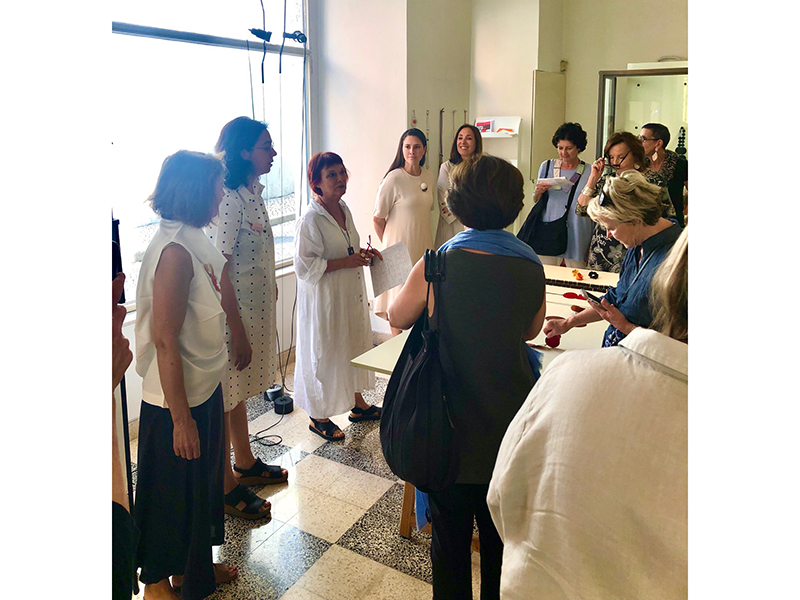
Next there was a pop-up for Kadri Mälk, a jeweler pivotal in the development of art jewelry in Estonia, who we’d met on a previous trip. She’s well known in Portugal and made the trip to help celebrate Cristina Filipe’s book launch with us. It was a pleasure to see her again, and to be reminded that the community of art jewelry is tightly connected.
Dinner that night was on the top floor of the Mercado da Ribeira, at a restaurant called Pap’Açorda; the meal finished with the richest chocolate mousse I’ve ever had—so thick it was almost a ganache. The local artists with us said it’s the best in Lisbon!
Next day started with a visit to the National Tile Museum, which is housed in a former convent and includes a chapel filled with tile mosaics and gold. Then on to brunch at the botanical garden for an incredible buffet, followed by a private tour of the Palace of Ajuda. Here we also had a visit behind the scenes with Valentim Quaresma, to see his sculpture, jewelry, and haute couture collection before they were all shown to the public. Next, on to another pop-up for AJF by five galleries from Porto: Galeria Autoria, Tincal lab, Collectiva, INTHEPENDANT Gallery, and Liliana Guerreiro Jóias. Altogether we saw the work of 25 wonderful artists from Porto.
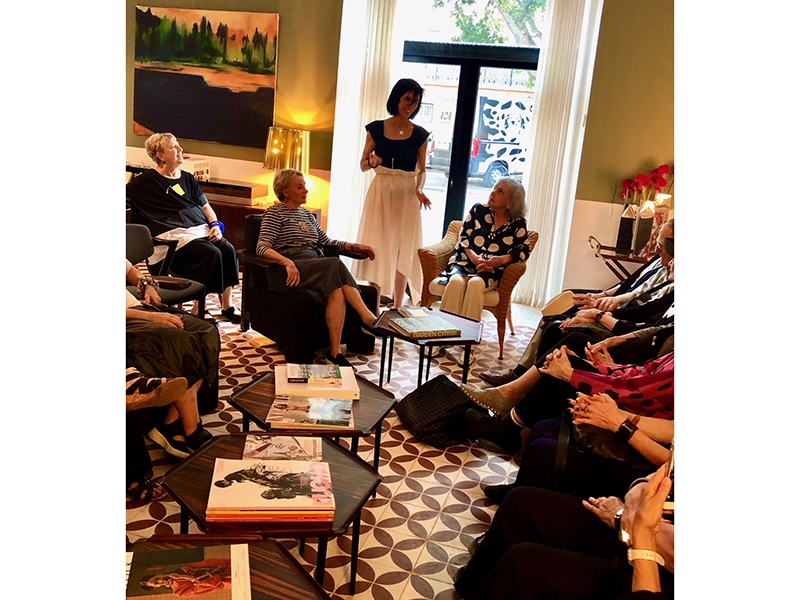
We then had the unique opportunity to meet Kukas, a legend of design and jewelry in Portugal, at the home/inn of one of her collectors, Filipa Fortunato. Now in her 90s, Kukas is recognized as the first great modern Portuguese jeweler, and she’s the connection to Scandinavia I mentioned before. Early in life, Kukas met Vivianna Torun Bülow-Hübe, from Sweden; Torun said in 1948 she “did not want to make jewelry for the wives of wealthy men to keep locked up in private.” Kukas was greatly influenced by this new kind of jewelry, so very different from traditional Portuguese filigree, and singlehandedly changed the course of modern jewelry in Portugal.
Dinner that night was at the home of Marta Costa Reis, whose jewelry we’d seen earlier in the trip. Her home is in a former convent on the outskirts of Lisbon, and she’d arranged for an exhibition of Carlos Silva’s work there, a demonstration of Portuguese filigree-making by artist Pedro Xavier, and a small exhibition of work by other artists, as well as her own. After an incredible buffet dinner, I went outside to listen to the Fado music she had also arranged for us; in the dark courtyard lit only by the full moon, I found all the Portuguese artists there, too—it just seemed right to listen in the dark and feel the essence of the music that is Portugal. My sense of being welcomed into the Portuguese artists’ community was as memorable as the Fado.
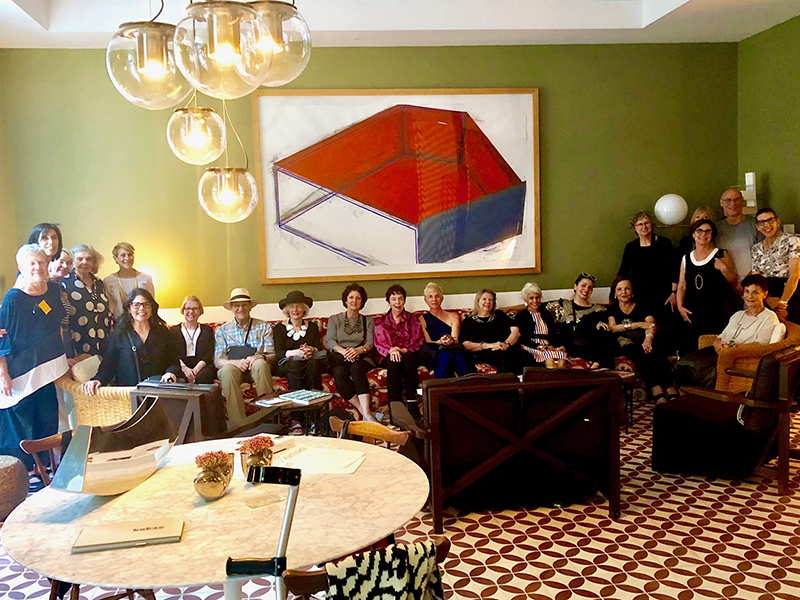
We started the next day with lunch at the Darwin Café, a wonderful restaurant in the Champalimaud Centre for the Unknown, a cancer and biochemistry research center at the edge of the river in a magnificent structure that seems designed to demonstrate that mankind is only a small part of the universe. Then on to more jewelry, this time the PIN (Portuguese contemporary jewelry association) exhibition organized by Cristina Filipe specifically for AJF. The exhibition, held at the Sociedade Nacional de Belas Artes, showed the work of different generations and styles of Portuguese jewelry. There were far more women jewelers than men, which surprised me.
Last stop of the day was Padaria 24 atelier, where we saw interesting and very experimental work from Pedro Sequeira, Inês Nunes, and Nininha Guimarães dos Santos. There was a free night after this, and again many of us found ourselves in the same restaurant.
Next morning started with a behind-the-scenes visit to the Design Museum (MUDE) to see the archives. We had a guided tour of the jewelry collection, led by the museum’s main curator, since the museum is currently closed for renovations. Next stop was Ar.Co, an independent school of the arts that has been the foundation and training ground for many of Portugal’s most noted jewelry artists. We met the head of the jewelry program, Catarina Silva, and were treated to a show by the first-year jewelry students.

How did their show go?
Michele Fox: The work we saw was outstanding! Although young, all the students clearly had a point of view. Many in AJF’s group spent time talking with individual students about what they looked for in a piece, and what was helpful to them in how shows were arranged.
The students were delighted to find we all wanted to buy their work, and for most of them it was the first piece they had sold. In watching their faces when someone asked to buy a piece, I was reminded again that when I buy a piece of art jewelry it’s a gift to the artist and to the gallery as well as to myself.
Next stop was Galeria Francisco Fino, where we saw the work of Ligia Dias, a Swiss artist of Portuguese descent. She had curated an iteration of her project Corner Piece, similar to what was presented at Design Miami in 2018. Lunch was at Espelho de Agua. Good food, again, and a wonderful view of the river. Then on to the atelier of Joana Vasconcelos. Although she started as a jeweler, she soon became a sculptor known internationally for super-sized works in many different materials. Her atelier occupies a very large, many-storied warehouse and employs staff that ranges from computer specialists to crochet artists to engineers and electricians as well as massage therapists and yoga instructors for staff health. We’d planned for only a short visit, but Joana was so enthusiastic we ended up spending most of an amazing afternoon with her. To end the day, we sat down to a farewell dinner at the home studio of a private chef, and talked about what we’d seen and considered where we might go next year.

You saw an unbelievable number of galleries and jewelers in a short time! Let’s finish by talking about the curatorial choices everyone was making—what you said they needed to think over before talking with you again. And talk a bit more about what you get from being part of AJF.
Michele Fox: The criteria sorted out for the group as a whole into design/shape, material, size, weight/balance/wearability, color or lack thereof, concept, and quality of construction. Price played a role, as did narrative and concept: When you wear a piece that’s social commentary, you have to be willing to have the conversation with someone who sees you wearing it. It was clear that for those who wanted to wear the work it had to be proportional to how they perceived themselves, or to whether it was meant to be worn for work, for fun, or to make a point. Others bought pieces meant only for display as artwork, so size mattered less than form. In the end, I think the comment that we all choose the perfect piece for ourselves was correct—we curate our appearance and our surroundings to show who we are and to make us happy with who we are. Perhaps we shouldn’t need to do this; maybe this says something about us as individuals or about our society. Nevertheless, decorating our environment and our bodies is as old as the cavemen, and I suspect it’s hardwired into our brains.
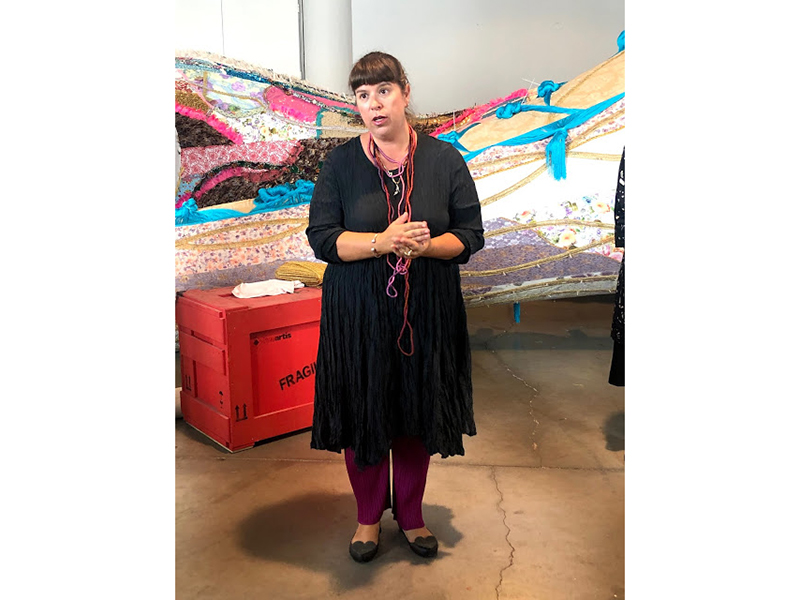
As to what I get from being a member of AJF, that answer is both easier and more complex. First, it gives me the chance to learn about art jewelry from the perspective of makers, gallerists, collectors, and museum curators. It’s hard for me to imagine another way to spend time with all of these different points of view at the same time. Second, it certainly helps me feel freer about the kind of work I make myself. Until I had spent time with AJF members, I was afraid to wear and show my more experimental work because it didn’t fit into the category of what most people think of as jewelry. It has surprised me that the response to my own work has been both accepting and encouraging—I suspect there are others like me who would find the same benefit to membership. This is a real community based on a common interest but with many different points of view that are all acceptable. Finally, it’s also an academic community that hosts an online library of everything related to our interests.
